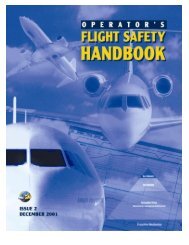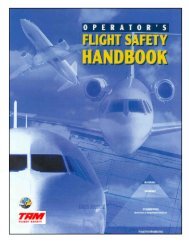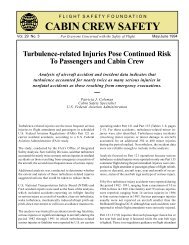Download PDF [10.9 MB] - Flight Safety Foundation
Download PDF [10.9 MB] - Flight Safety Foundation
Download PDF [10.9 MB] - Flight Safety Foundation
Create successful ePaper yourself
Turn your PDF publications into a flip-book with our unique Google optimized e-Paper software.
mechanical resistance. The first officer commented,<br />
“That’s what it was doing the other<br />
day, too.”<br />
The captain applied additional pressure to<br />
the power lever and heard a pop as the lever<br />
moved full forward, the NTSB report said. The<br />
lever jammed in this position, causing engine<br />
torque and temperature to exceed limits.<br />
The pilots shut down the left engine, declared<br />
an emergency and diverted the flight to<br />
Bishop International Airport in Flint, Michigan.<br />
“After the engine shutdown, both primary<br />
flight displays went blank,” the report said.<br />
“The captain reset the right generator, and the<br />
flight displays regained power.” However, the<br />
displayed heading information was erroneous<br />
because the gyros had been reset. The report<br />
said that the crew did not check the headings<br />
against the magnetic compass.<br />
VMC prevailed at the Flint airport, with<br />
surface winds from 290 degrees at 18 kt. The<br />
pilots were cleared by ATC to land on Runway<br />
27 but became confused about their heading<br />
and location while circling to land. The airport<br />
traffic controller then cleared the crew to<br />
land on any runway. The first officer replied,<br />
“We’re taking this one here. We’re turning<br />
base to final.”<br />
The Avanti touched down long on Runway<br />
18, which is 7,848 ft (2,392 m) long. “At the<br />
point of touchdown, there was about 5,000 feet<br />
[1,524 m] of runway remaining for the landing<br />
roll,” the report said.<br />
The captain applied reverse thrust from<br />
the right engine, and the airplane began turning<br />
right. He then reduced reverse thrust and<br />
applied full left rudder and left brake, but the<br />
airplane veered off the right side of the runway<br />
and flipped inverted. The pilots and the two<br />
passengers sustained minor injuries.<br />
“Examination of the left engine revealed that<br />
the Beta clevis pin was installed in reverse [during<br />
maintenance], which caused an interference<br />
with a fuel control unit interconnect rod,” the<br />
report said. “Due to the interference, the power<br />
lever control linkage was jammed in the fullforward<br />
position.”<br />
FLIGHTSAFETY.ORG | AEROSAFETYWORLD | MAY 2013<br />
Control Lost During EMS <strong>Flight</strong><br />
Pilatus PC-12/45. Destroyed. Ten fatalities.<br />
Two physicians and a nurse were aboard<br />
the PC-12 when the flight crew landed<br />
the emergency medical services aircraft in<br />
Patna, India, the night of May 25, 2011. After<br />
a critically ill patient and an attendant were<br />
boarded, the aircraft departed from Patna for<br />
the return trip to Delhi.<br />
“Weather in Delhi started deteriorating as the<br />
flight came close to Delhi,” said the report by the<br />
Committee of Inquiry formed by the Indian Directorate<br />
General of Civil Aviation. “Widespread<br />
thunderstorm activity was seen north-northeast<br />
of the Delhi airport [and] moving south.”<br />
The PC-12 was nearing the airport and<br />
descending through 12,500 ft when ATC radar<br />
showed abrupt and rapid altitude changes to<br />
14,100 ft, 13,100 ft and 14,600 ft before groundspeed<br />
decreased substantially; the aircraft then<br />
entered a steep right turn and descended at rates<br />
nearing 11,600 fpm. During this time, ATC<br />
received two weak radio transmissions from the<br />
crew, both indicating that the aircraft was “into bad<br />
weather.” Radar contact was lost at 1,600 ft, and attempts<br />
to hail the crew by radio were unsuccessful.<br />
The aircraft had struck a house in a residential<br />
area of Faridabad, about 15 nm (28 km) from<br />
the airport. All seven people aboard the aircraft<br />
were killed, as were three people in the house.<br />
The PC-12 was destroyed by the impact and<br />
a subsequent fire. Examination of the wreckage<br />
revealed that the aircraft was intact before<br />
it struck the house, and there was no sign of<br />
mechanical failure.<br />
“It is probable that a series of up- and downdrafts,<br />
turbulence (moderate to heavy) and the<br />
dark night conditions [had] caused the crew to<br />
become disoriented,” the report said. “The subsequent<br />
mishandling of [flight] controls caused<br />
the aircraft to [stall and] enter a spin.”<br />
Gear Lubrication Neglected<br />
Beech 99. Substantial damage. No injuries.<br />
After dropping parachutists near Cedartown,<br />
Georgia, U.S., the morning of April<br />
10, 2011, the pilot turned back toward the<br />
ONRECORD<br />
The pilots … became<br />
confused about their<br />
heading and location<br />
while circling to land.<br />
| 57


![Download PDF [10.9 MB] - Flight Safety Foundation](https://img.yumpu.com/18550968/59/500x640/download-pdf-109-mb-flight-safety-foundation.jpg)

![Download this Issue [PDF 7 MB] - Flight Safety Foundation](https://img.yumpu.com/18859635/1/190x245/download-this-issue-pdf-7-mb-flight-safety-foundation.jpg?quality=85)

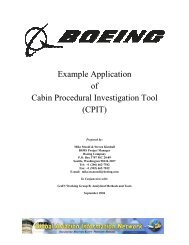
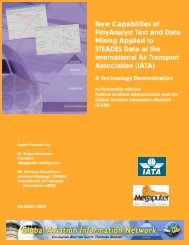
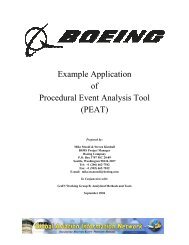

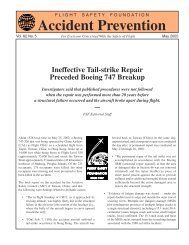
![Download [PDF 8 MB] - Flight Safety Foundation](https://img.yumpu.com/18859366/1/190x245/download-pdf-8-mb-flight-safety-foundation.jpg?quality=85)
